How Re-Cycling Can Stretch Your Budget
After years of building furniture and other traditional woodworking projects where standard clamps worked perfectly, I ventured into my first boat project: a cedar strip canoe made with bead and cove joinery. It seemed simple enough: just fill the cove with glue, drop the bead of the adjoining strip in and staple to the forms. Of course, the areas at the forms were nice and tight, but sections in between started to show gaps because wood isn't always straight. All those forces from wavering grain patterns were causing me some alignment angst.
Poking around some forums and blogs run by more experienced boat builders, I found a brilliant solution: Bicycle inner tube tires. Even better, this brilliant solution was free! I drove down to the local Schwinn bike store and asked if they had any old flat bike inner tubes. The guy disappeared into the back area, then reappeared with a good sized box - a spaghetti-plate mix full of tubes. Tubes from small kids bikes to fat mountain bikes to long, skinny racing bikes. No charge.
Once home, I cut a few apart. And here is your big warning: some cyclists attempt to repair their punctured tubes with liquid chemicals. And the chemicals often remain liquid forever. And I have no idea what is in those funky green colored chemicals, but I KNOW I don't want that crap seeping into the grains of my expensive lumber. Even if you mopped it up quickly, who knows how it will react to your epoxy, your varnish, glue, paint, etc. So be careful.
Now, how to harness that rubber to hold my beaded edges into the coved edges while the glue set? I took a 6" piece of tubing and stretched it between the jaws of some simple spring clamps. The spring clamps had enough tension to hold the ends of the bike tube, which was pulling the strips down. By the way, if you can't stand the thought of money in your wallet, go to Rockler Woodworking and Hardware: They sell a very similar set up ("Bandy Clamps") for $14 - $28 a pair
 |
It don't get much cheaper than this. |
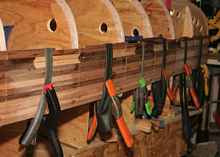 |
Pulling cove and bead canoe strips together. |
 |
Pulling outer stem tight against canoe hull. |
This little experiment was just the beginning of my new love affair with old bike tubes. I’ve found numerous situations where the versatility of bike tubes outshined every other clamp I own. I often combine them with other traditional clamps, which can be easier to adjust the tension - especially where I need to keep one hand on the item being clamped. My current favorites are the Irwin Quick Grips, which can be spendy, but experiment with what you have on hand and think through the operation. Sometimes you can simply use a spare 2X4 as a lever.
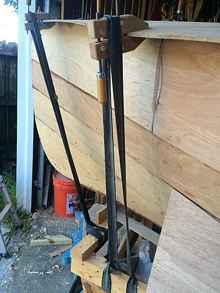 |
Pulling foredeck down over curved frames. |
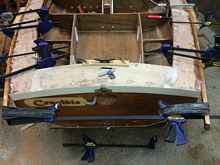 |
Pulling rub rails together at the stern. |
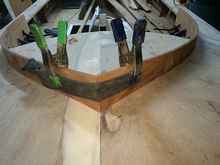 |
I defy anyone to show me a better, simpler, cheaper solution to these coaming clamping situations. |
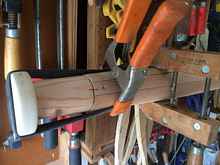 |
It holds even the most difficult clamping jobs. |
Besides being free, bike tubes have a ton of other attributes you will love:
- Glue, including epoxy, won’t stick to them
- They can handle a LOT of tension
- You can use multiple tubes together to increase tension
- You can tie multiple tubes together in a long chain
- Soft - unlikely to mar your wood
- Disposable
- Durable - bear down with a C clamp and you can probably still reuse it
- They hold simple knots well
- Flexible around curves
- Easily cut to size
- Very long shelf life
- Compact storage
- Did I mention free?
One other note of caution: Because they can handle a lot of tension, that tension can wallop you if something suddenly releases. If you need to really crank on something, check the tubes for any slices that could spread under tension. Double up the tubes. Double check that your other clamps are set tight enough to handle it. And be wary of standing in the line of fire should something release unexpectedly.
|













